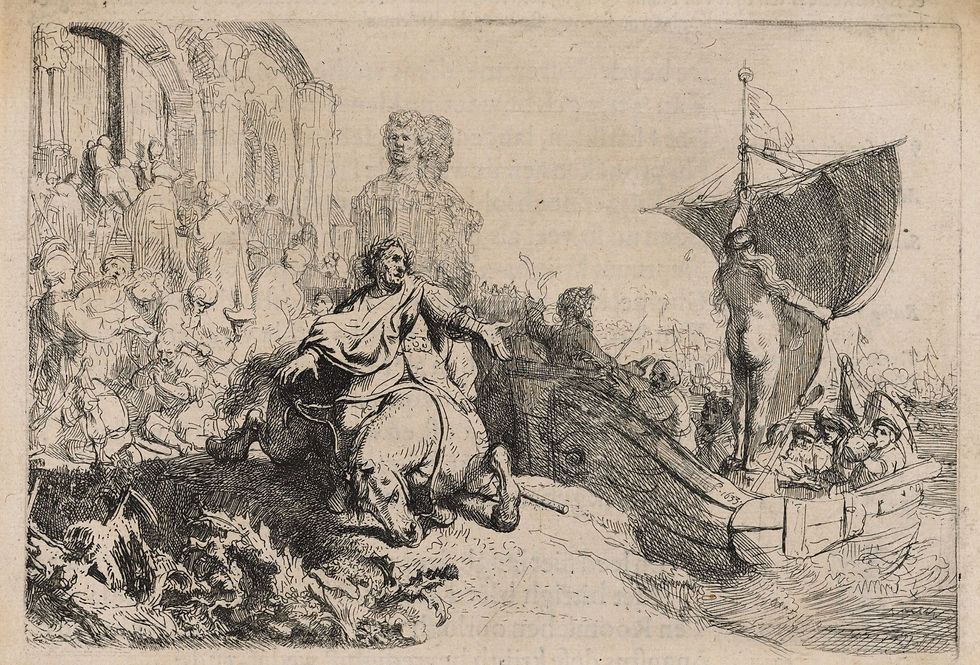What Makes Old Books Valuable?
- Steven de Joode
- Jan 2
- 5 min read
Updated: Mar 24
It’s a persistent misconception that old books are inherently valuable. In reality, age has little effect on a book’s worth. You can purchase a 17th-century book for just a few tens of euros. So, what does make books valuable? Broadly speaking, there are six factors that determine a book’s value: historical importance, illustrations, binding, condition, provenance, and rarity.

Historical Importance
Books that have fundamentally changed our understanding of life, the universe, or ourselves will always be collected. Books that introduce a groundbreaking idea, or describe a country, species, cultural practice, etc., for the first time are often avidly collected. The same applies to the first book printed in a particular language or country.
One well-known example is Copernicus's De revolutionibus (1543), the book in which he first described the heliocentric model of the universe. Copies of this work often fetch around €500,000 at auction.
Another example is the famous Bay Psalm Book (1640), a modest psalm book named after its place of printing, the Massachusetts Bay Colony. It was the first book printed in British America, with a copy fetching over $14 million at auction in 2013.
For most of us, however, owning such iconic works is out of reach. Fortunately, there’s much more on offer than just these historical highlights. What’s considered desirable also changes over time. For instance, the small Elzevir editions of classical authors were hugely popular in the 19th century but are now worth relatively little due to declining interest.
On the other hand, printed material revealing the fringes of history is becoming increasingly sought after. A fascinating example is this unrecorded edition of a guide for sex tourism in Paris pictured below. Sex tourism boomed in Paris in the second half of the 19th century, prompting the publication of many guides to aid tourists. The present guide, probably published at the beginning of the 20th century, exists in several editions, all of which are extremely rare.
![Vient de paraitre. Le guide secret pour étrangers et viveurs. Secret Directory for foreigner Bachelors in Paris. Zum amusieren der Jungersellern[!]. Casas nocturnas. (Colophon: Paris, Éditions Lagache, [early 20th century?]).](https://static.wixstatic.com/media/3b7891_2021d678828042b9ae7f848c6e5489f6~mv2.jpg/v1/fill/w_980,h_1388,al_c,q_85,usm_0.66_1.00_0.01,enc_avif,quality_auto/3b7891_2021d678828042b9ae7f848c6e5489f6~mv2.jpg)
Illustrations

One of the factors that make a book more appealing is, of course, illustrations—we all love looking at pictures. In the 15th century, books were illustrated with woodcuts, later followed by engravings, etchings, aquatints, wood engravings, and lithographs. A book’s value increases significantly if it features illustrations by a renowned artist.
For instance, the value of Herckmans’ Der Zee-vaert Lof (1643) is largely attributed to the etching by Rembrandt that accompanies it. While Rembrandt illustrated very few books, prolific artists like Romeyn de Hooghe and Jan Luyken produced a vast amount of work, much of which—especially de Hooghe’s—is still highly appreciated today.
Natural history illustrations, particularly when hand-coloured, are also highly sought after. One of the pinnacles of natural history illustration is Audubon’s The Birds of America (London, 1827–1838), a monumental series of books containing no fewer than 435 hand-coloured illustrations. In 2018, the magnificent Duke of Portland copy was auctioned for $9,650,000.


Binding
During the hand-press period, slim booklets, such as pamphlets consisting of just a few gatherings, were often hastily sewn together and sometimes given a simple cover. Larger books, however, were usually sold unbound, leaving the purchaser to arrange for their binding.
Depending on the buyer’s budget, they could choose from various materials and designs, ranging from plain vellum to elaborately gilt-tooled calf or morocco leather. Today, the most ornately decorated bindings are generally the most valuable, especially if they can be attributed to a renowned workshop. A fine example is the bindings from the 18th-century First Stadtholder’s Bindery (The Hague).
Interestingly, simpler original bindings are now increasingly sought after. In the late 18th and early 19th centuries, books were often issued in plain printed wrappers, which were later replaced by elegant leather bindings. As a result, the original wrappers have become extremely rare. With collectors now favouring “authenticity,” such books are in high demand.
A notable example is the first edition of Dumas’ Les Trois Mousquetaires (1844). In 2017, Christie’s described it as “The first edition of the author’s best-known work, in the original wrappers: a rare survival.” The set sold for $60,000.

Condition
The condition of a book has a much greater impact on its value than people often realise. Even a book from the 16th or 17th century must be in good condition and, of course, complete. Missing plates or text leaves, a damaged binding (e.g., detached spine or boards), or a contemporary binding replaced with an unattractive later one can dramatically reduce a book’s value. Collectors want books in good condition, ideally bound close to the time of printing.

Provenance
With many texts now widely available online—often for free—collectors are raising their standards. They are no longer just looking for texts but also for fascinating cultural artefacts.
Books with unique characteristics are increasingly popular. An interesting provenance, annotations by the author or a notable figure, or books from a prestigious library can significantly enhance a book’s value.
For example, copies of Adam Smith’s An Inquiry into the Nature and Causes of the Wealth of Nations (1776) typically fetch around €100,000 at auction. However, in 2018, a copy from Smith’s personal library appeared on the market. Featuring his ex-libris on the endpaper; it sold for £908,750 (including premium).
Rarity
Of all the factors mentioned, rarity has the least influence on value. A book can be extremely rare (or even unique), but if no one desires it, it won’t be worth much. Conversely, a combination of two or more of the factors outlined above can greatly increase a book’s value.
For example, the aforementioned Birds of America set combines historical importance, an exquisite binding, intriguing provenance, excellent condition, and exceptional rarity.
.png)
![Lothar Meggendorfer. Grand cirque international. Paris, Nouvelle Librairie de la Jeunesse (printed in Esslingen by Schreiber), [not before 1887].](https://static.wixstatic.com/media/3b7891_5ee10792001e4ecc8465758a0465eb1f~mv2.jpg/v1/fill/w_980,h_551,al_c,q_85,usm_0.66_1.00_0.01,enc_avif,quality_auto/3b7891_5ee10792001e4ecc8465758a0465eb1f~mv2.jpg)

Comments